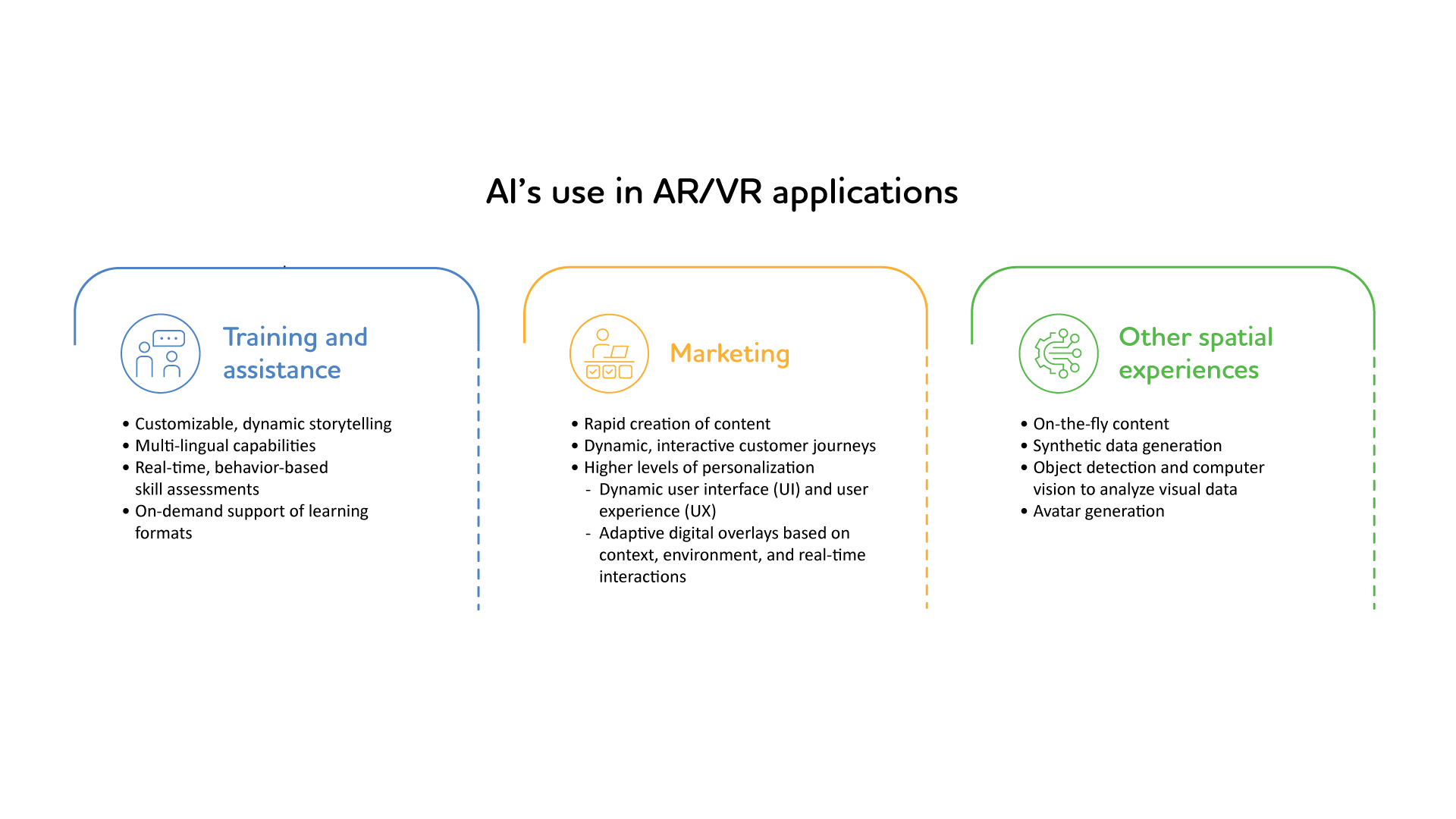Solution
Highlights
- Immersive technologies aren’t new. But new developments and the power of AI are giving enterprises across industries more reasons to consider using them to deliver more interactive experiences.
- AI has the potential to jumpstart the adoption of immersive technologies and enhance a number of AR/VR applications, including those for training, marketing, and spatial experiences.
- Enterprises will have to navigate challenges as they adopt immersive technologies, including choosing the right headsets, managing data and systems integration, and dealing with complex, large-scale deployments that may include end customers.
On this page
Immersive breakthrough
Like other technologies pushing boundaries and challenging norms, immersive technologies have experienced uneven adoption. However, change is coming as enterprises across industries leverage them to provide their employees and customers with interactive experiences that deliver real value.
Enterprises, especially those in healthcare, manufacturing, aerospace, and retail, are adopting virtual reality (VR), augmented reality (AR), mixed reality (MR), and extended reality (XR) for a variety of interactive applications that involve design, training, collaboration, customer engagement, and more. With the addition of artificial intelligence (AI), especially generative AI (genAI), applications are becoming more creative and engaging and can be personalized to users’ specific needs and preferences.
AR and VR can be traced, at least conceptually, all the way back to the 1930s. The technology got a big lift via gaming when Oculus unveiled its Rift VR headset prototype in 2010. Other important developments followed – Google Glass AR and Microsoft’s HoloLens, along with apps that use the technologies so customers can experience products, such as Maybelline’s virtual makeover and online makeup application tools. VR delivers a fully simulated environment, while AR combines real and virtual content.
Until recently, adoption had been limited, in part because of the discomfort of wearing a heavy AR/VR headset, the disconnect with the real world when wearing one, and the high costs associated with the technology. Despite a slow start in sales, the Apple Vision Pro released in early 2024 helped jumpstart the immersive renaissance. Apple calls its new headset a spatial computer, which users can control via eye-tracking and hand gestures.
The AI jumpstart
Like nearly every other technology, AI will accelerate the potential of AR/VR applications. Consider an AI-powered immersive training tool that’s voice- activated. Users could speak prompts into the tool to navigate through the training, and the AI technology could learn to offer tailored reinforcements where users might need more support. Users could direct the tool to provide various interactions, such as simulated scenarios, to help them practice the training.
AI-powered technology could bring chatbots or virtual agents to life, as they are used in an immersive virtual store. Rather than responding with scripted answers, these AI chatbots could deliver information about a product in a more natural, conversational manner that is also adapted to a buyer’s actions and prompts.
Initially, we can expect to see AI embedded in core spatial engines. Then, AI will begin appearing in applications and being used for content creation, adaptive conversation, speech and language. Here’s a breakdown of how AI will show up in AR/VR applications:
Immersive possibilities
When the Catholic University of America wanted to better support its nursing students in their studies, so they’d thrive in the profession, it turned to immersion technology. The university partnered with TCS to develop a virtual, in-hospital environment featuring AR and VR. The students could practice and simulate caregiving, preparing them for real-life scenarios in hospitals. Regular exposure to simulation better equipped the nurses for on-floor execution, leading to fewer dropouts and better multi-tasking abilities.
Immersive technologies also make inroads in other industries, including industries with hazardous environments, such as mining and oil and gas. XR, for example, can play a vital role by enabling AR-based remote inspection and assistance, visually guided drilling operations, real-time heavy equipment operator assistance, assisted maintenance and repair of assets, and mine operator safety training. Immersive use cases deliver even greater benefits when combined with digital twin or artificial intelligence (AI) technologies. Avery Dennison has explored using VR to provide better customer experiences, testing it in sales enablement and digital twin simulations for supply chain optimization and product performance.
Now, with newer, more advanced headsets that don’t rely on physical interactions, either through a mouse or keyboard, a touchscreen, or hand-held physical controllers, companies can begin creating the kinds of immersive, interactive, and inclusive experiences that engage and delight customers. Moreover, these experiences can unlock new commercial partnerships, increase direct sales and ancillary revenue, and drive brand loyalty.
The highly competitive airline industry is starting to experiment with immersive tech to transform passengers' experiences in airport lounges and during flights. For instance, passengers can use AR/VR headsets to access contextual and in-moment services tailored to them. Passengers can enjoy highly immersive pre-flight and in-flight entertainment and shopping experiences, and airline companies and their ecosystems can deliver engaging airline offers to alert them of the latest deals and promotions.
AI will accelerate the potential of AR/VR applications. Consider an AI-powered immersive training tool that’s voice-activated. Users could speak prompts into the tool to navigate through the training, and AI technology could learn to offer tailored reinforcements where users might need more support.
A new era of devices
When Apple released its headset, Apple Vision Pro set a new bar. While several headsets can deliver great experiences, Apple’s has one of the best display technologies (micro-OLED with 23 million pixels) and uses more than 15 sensors to provide superior tracking. However, its high price tag has hindered its adoption, according to the reports.
Companies that want to consider using immersion tech must determine what’s most important for their implementations. If headsets must be made available to many users, the price will matter.
Immersion technology usage will also dictate which headsets to choose. For training and safety applications, users will likely need to wear headsets for extended periods, so the lighter and more comfortable, the better. Battery life will also be a significant factor here. Other considerations include how photorealistic you want the imagery and experiences to be, and whether you want to enable interaction via voice controls, hand or eye gestures, or moving your head (or all the above).
Navigating barriers
For enterprise-scale immersive technology, it will be critical to choose the best headset that meets your requirements today and into the future. For immersive applications used internally, organizations will need to ensure seamless implementations that can span geographies, business units, and brands within your ecosystem. You’ll have to map out any necessary data and systems integration (including legacy systems) to connect the dots of an end-to-end implementation.
When sharing devices with end customers, expect more complex deployments. It will be important to ensure everyone can engage in experiences whether they want to participate in an immersive one or not. One way to mitigate that is to use newer devices, such as the Apple Vision Pro or Meta’s Quest 3, which support mixed reality so users can also take advantage of more traditional apps such as messaging, web browsing, or even watching a movie.
To navigate the challenges of immersive adoption, work with a trusted partner who will help determine which strategies, headsets, and applications best address your specific business needs. Consider choosing a partner that offers a framework that guides you step-by-step to define overall architecture. Start with a single use case, then test and evaluate its impact. If it’s delivering as desired, reimagine it for a large-scale initiative.
As more enterprises begin rolling out immersive experiences, both within their organizations and for their end customers, the technology will move beyond the gamers’ reach and into everyday use. At that point, immersive technology will begin delivering solid business value.







